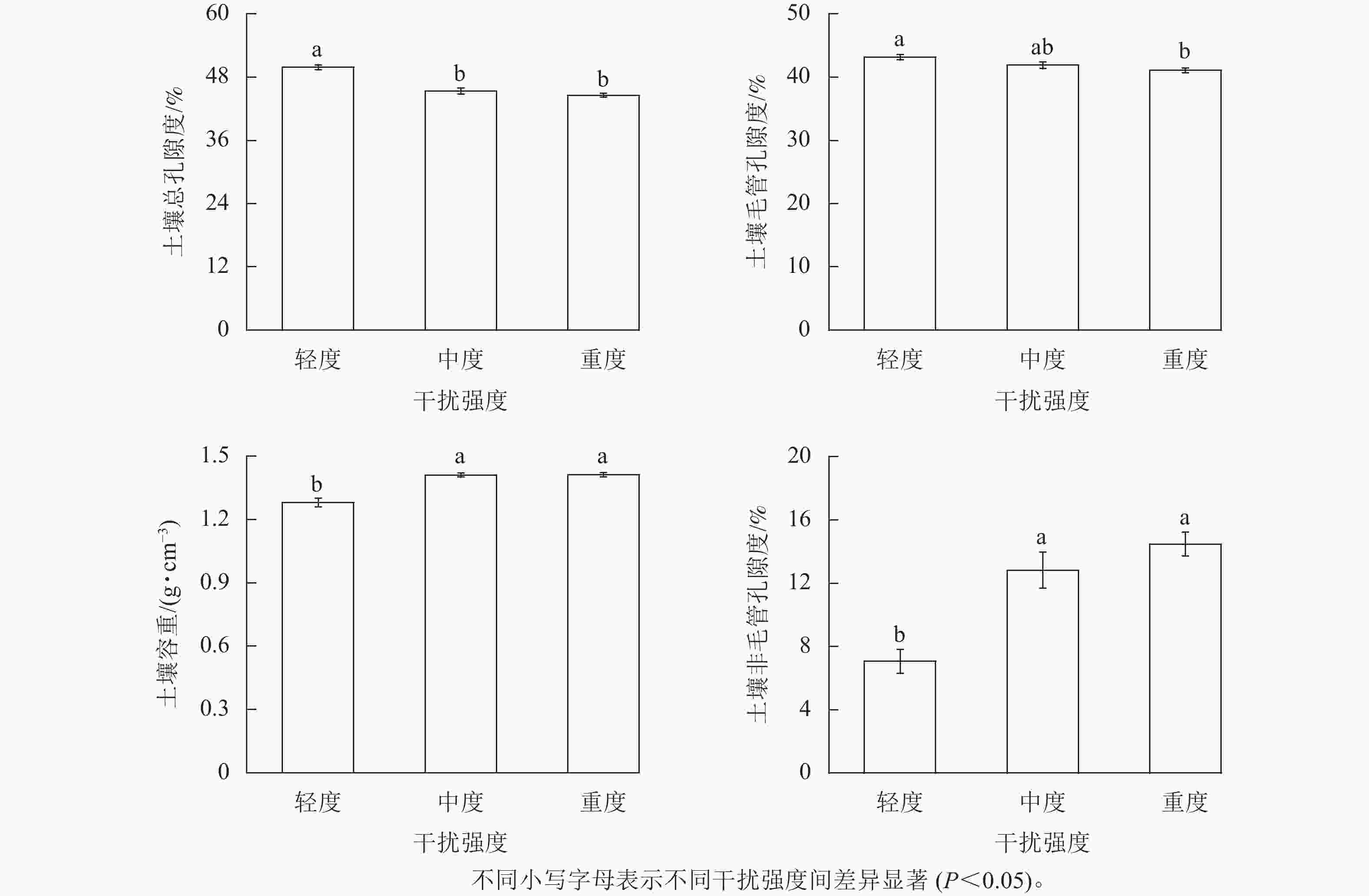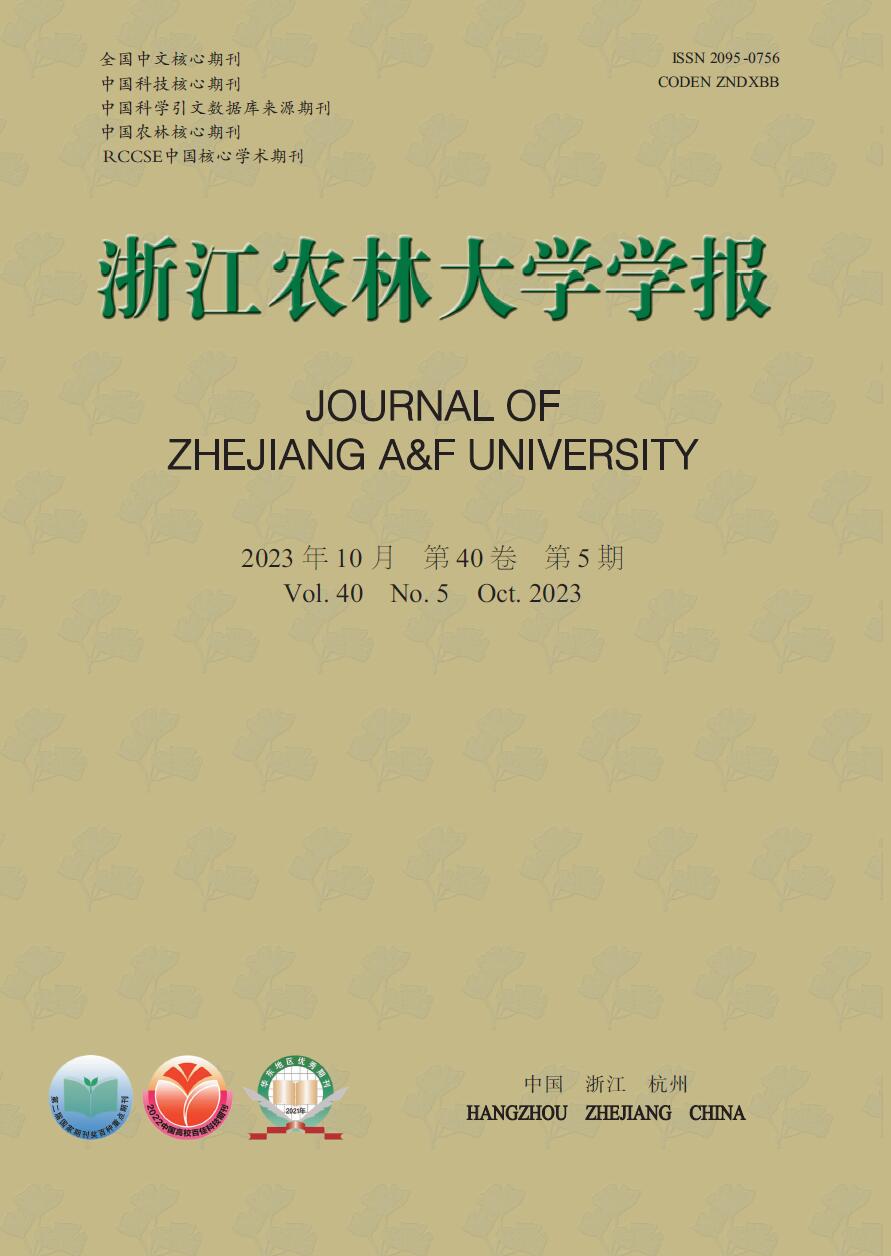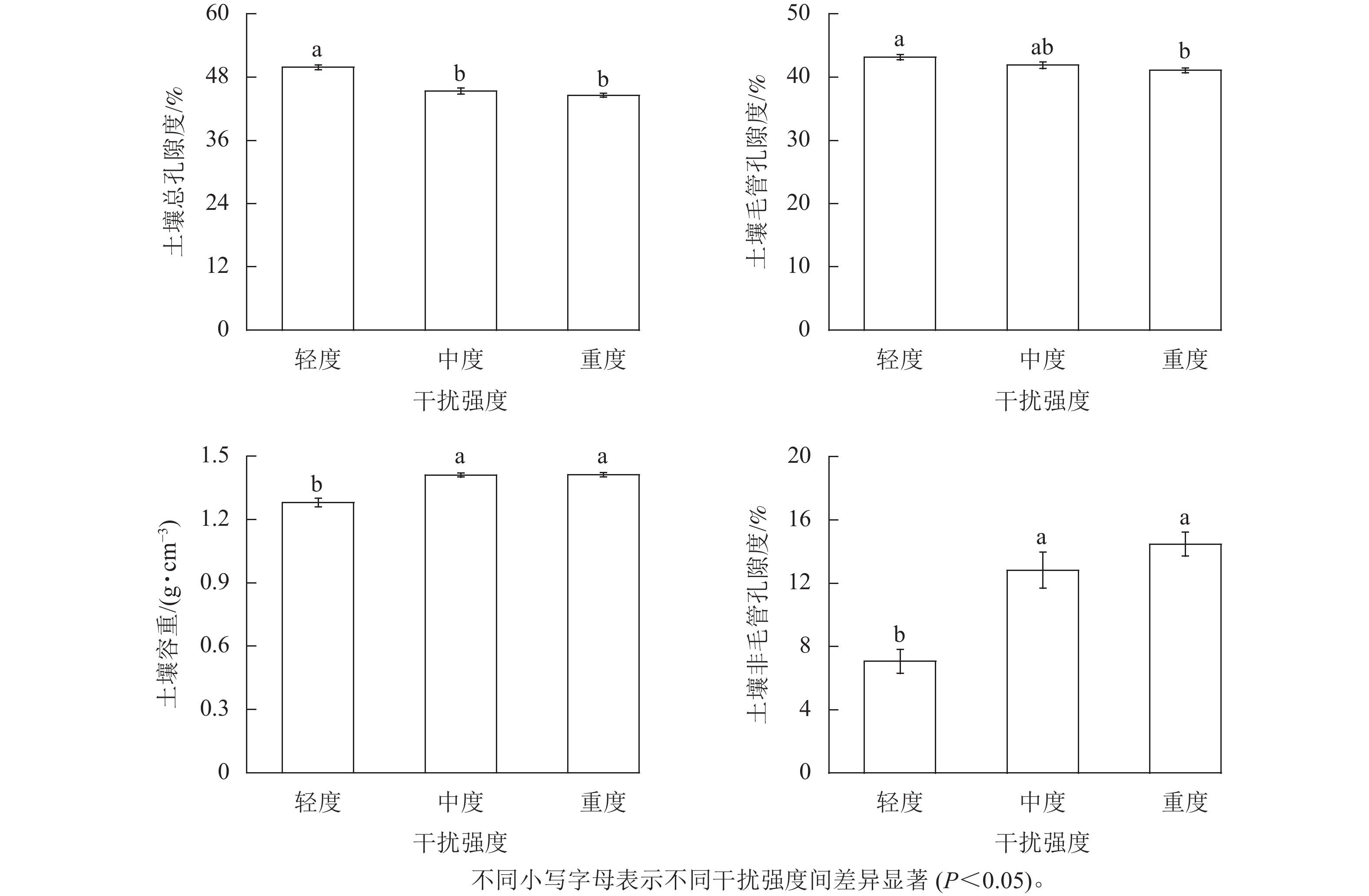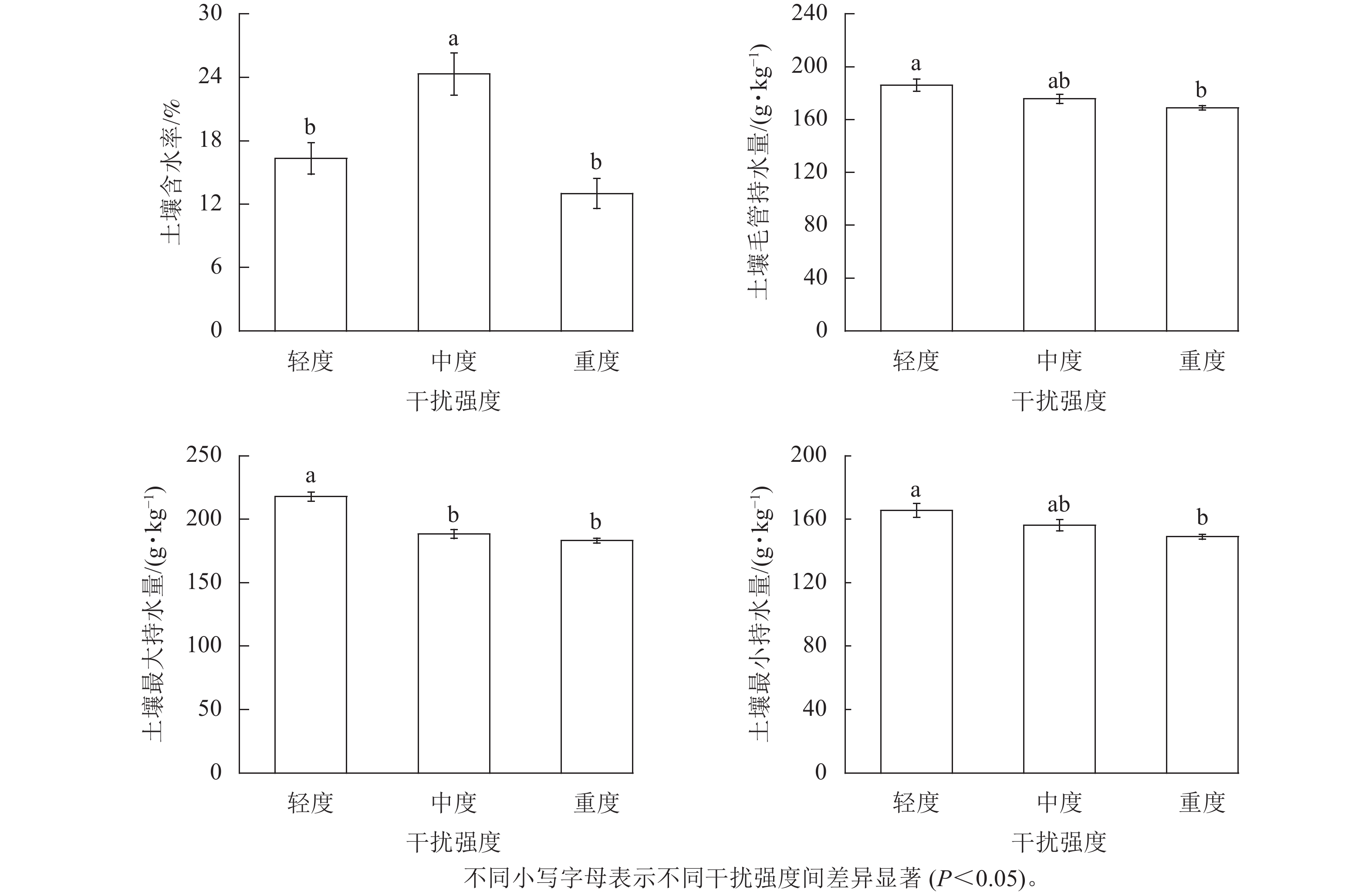-
土壤物理性质反映土壤结构的稳定性,在一定程度上可以表征土壤的质量与退化状况[1]。除地形地貌、土壤特征、降雨差异和植被类型等外[2],人类活动也是影响土壤性质和土壤形成过程的重要因素[3−4]。适度的干扰会对物种多样性和生物量以及种群、群落、生态系统甚至整体景观格局有正向促进作用,而长期的人为干扰会造成土壤压实,降低土壤团聚体稳定性、持水能力和微生物活性等[5]。郭宝宝[6]通过研究不同人为干扰强度对森林土壤水分物理性质的影响发现:土壤容重随人为干扰强度的增加呈明显增加的趋势。庞学勇等[7]通过研究人为干扰对川西亚高山针叶林土壤物理性质的影响发现:随人为干扰强度的增加,土壤粉粒、黏粒含量和大团聚体数量减少,土壤表层孔隙度减小,土壤有效水降低。张希彪等[8]通过研究人为干扰对黄土高原子午岭油松Pinus tabuliformis人工林土壤物理性质的影响发现:随人为干扰强度的增加,0~50 cm土层土壤砂粒含量均增加,粉粒含量与黏粒含量均下降,土壤容重增加了0.11~0.41 g·cm−3,土壤总孔隙度、毛管孔隙度、非毛管孔隙度、毛管持水量、自然含水量、饱和持水量、田间持水量和土壤有效水含量均下降。人为干扰通过影响土壤物理性质会改变地表径流和土壤侵蚀程度[9],进而影响植物群落分布[10]、物种多样性和生物量[11]、土壤养分含量[12]以及生态系统稳定性[13]。目前,不同程度人为干扰对土壤物理性质的影响多集中在城市绿化用地[14]、山地和森林[15−16]、湖滨湿地[17]等方面,而针对河岸带湿地的研究相对较少。
河岸带是一种生态交错带类型,是水陆交互影响下形成的特殊生境和生态系统,具有防止河岸侵蚀与水土流失、调节洪水、净化水质、维持生物多样性等生态功能[18−19]。河岸带生态系统是一个脆弱的、易受水文、人类活动等干扰而退化的生态区域,具有明显的边缘效应和独特的生态过程[20],且其退化和破坏速度显著快于其他陆地生态系统[21]。农业开垦、城市开发、水利工程、道路和桥梁的修建等人为干扰影响植被类型演替[22−23],造成河岸带退化,加剧水土流失,危害河岸带景观的连续性,破坏了河岸带生态服务功能,严重威胁河岸带生态系统安全与健康[24−26]。
本研究以黄河中下游河岸带为例,根据实地调研结果,对不同干扰强度(轻度干扰、中度干扰、重度干扰)河岸带的土壤物理性质进行调查,分析河岸带土壤物理性质随土层深度的变化规律,对比不同干扰强度河岸带土壤物理性质的差异,探索不同干扰强度河岸带土壤物理性质的相互关系,为河岸带的生态修复和管理提供理论依据。
-
以黄河流域中下游洛阳—郑州段河岸带湿地作为研究对象,地理位置为34.823°~34.980°N,112.777°~113.665°E。研究区春季干旱少雨,夏季炎热多雨,秋季凉爽,冬季气候干燥雨雪稀少。年平均气温为15.0 ℃,最冷月平均气温为0 ℃;最热月平均气温为27.0 ℃,年均降水量为610.0 mm。主要植被类型有芦苇Phragmites australis、白茅Imperata cylindrica、狗牙根Cynodon dactylon、雀麦Bromus japonicus、柽柳Tamarix chinensis等。
-
在黄河洛阳—郑州段选择地形地貌和地表植被覆盖相对一致的河岸带区域,依据人为踩踏程度的不同,选择3种不同干扰强度的样地类型,分别为洛阳市偃师市邙岭乡轻度干扰河岸带、郑州市巩义市S237省道大桥中度干扰河岸带、郑州市黄河湿地公园重度干扰河岸带。样地具体情况如表1所示。其中,洛阳市偃师市邙岭乡河岸带位于黄河保护区内,周围采用栅栏圈围,受人为干扰程度较小,人流量20人·周−1;郑州市巩义市S237省道大桥下河岸带人流量50人·周−1;郑州市黄河湿地公园河岸带人类活动较多,人流量120人·周−1。
干扰强度 地理位置 北纬(N) 东经(E) 海拔/m 优势植被 轻度 洛阳市偃师市邙岭乡 34.823° 112.785° 91 芦苇、白茅、雀麦、狗牙根、柽柳 中度 郑州市巩义市S237省道大桥 34.839° 113.060° 87 芦苇、白茅、雀麦、狗牙根 重度 郑州市黄河湿地公园 34.841° 113.140° 88 白茅、雀麦、狗牙根 Table 1. Basic condition of study piots
2021年10月,在3种不同干扰强度的区域内选择近河岸带200 m×200 m样地,进行5×3网格化划分,共设置15个样点,记录每个样点的经纬度。以每个网格划分点为中心采样点设置5 m×5 m大样方,在每个大样方内随机设置3个1 m×1 m的小样方,用环刀法与土钻法分层采集0~10、10~20、20~30 cm土层样品,分别装入带编号的密封袋内。
-
土壤容重采用环刀法测定,土壤含水率采用烘干法测定,土壤毛管持水量、土壤最大持水量、土壤最小持水量、土壤总孔隙度、土壤毛管孔隙度和土壤非毛管孔隙度采用浸水法测定[1]。
采用Excel 2016和SPSS 25.0软件进行数据处理和分析。采用单因方差分析(one-way ANVOA)检验不同干扰程度土壤物理性质的差异显著性;采用 Pearson 相关分析法分析土壤物理性质之间的相关性;采用Origin 2019绘图。
-
由图1可见:河岸带土壤总孔隙度、土壤毛管孔隙度随人为干扰程度的增加而减小;土壤容重、土壤非毛管孔隙度随人为干扰强度的增加而增加。河岸带0~30 cm土层土壤容重为1.28~1.41 g·cm−3,均值为1.37 g·cm−3,中度、重度干扰土壤容重显著(P<0.05)高于轻度干扰。河岸带0~30 cm土层土壤总孔隙度为44.5%~49.8%,均值为46.6%,中度和重度干扰土壤总孔隙度显著(P<0.05)低于轻度干扰;河岸带0~30 cm土层土壤毛管孔隙度为41.0%~43.1%,均值为42.0%,轻度干扰土壤毛管孔隙度显著(P<0.05)高于重度干扰;河岸带0~30 cm土层土壤非毛管孔隙度为7.1%~14.5%,均值为11.4%,中度、重度干扰土壤非毛管孔隙度显著(P<0.05)高于轻度干扰。

Figure 1. Effects of different human disturbance intensity on soil bulk density and porosity of 0−30 cm riparian zone of Yellow River
由表2可见:3种不同人为干扰强度河岸带土壤容重均随土层深度增加而增加,但均无显著差异。轻度、重度干扰的土壤总孔隙度、土壤毛管孔隙度和土壤非毛管孔隙度在3个土层间均无显著差异。中度干扰下,0~10 cm土层土壤总孔隙度、土壤毛管孔隙度显著高于20~30 cm土层,而中度干扰下20~30 cm土层土壤非毛管孔隙度显著(P<0.05)高于0~10 cm土层。
干扰强度 土层深度/cm 土壤容重/(g·cm−3) 土壤总孔隙度/% 土壤毛管孔隙度/% 土壤非毛管孔隙度/% 轻度 0~10 1.24±0.03 a 50.73±0.79 a 43.85±0.82 a 5.42±1.38 a 10~20 1.26±0.02 a 49.38±0.88 a 42.57±0.59 a 8.05±1.18 a 20~30 1.32±0.03 a 49.45±0.82 a 42.86±0.79 a 7.69±1.34 a 中度 0~10 1.40±0.02 a 47.46±1.02 a 43.70±0.73 a 8.83±1.71 b 10~20 1.41±0.02 a 44.92±0.88 ab 41.45±0.87 ab 13.63±1.70 ab 20~30 1.43±0.02 a 43.65±1.13 b 40.39±1.00 b 15.96±2.09 a 重度 0~10 1.41±0.02 a 44.72±0.68 a 41.35±0.61 a 13.93±1.27 a 10~20 1.41±0.01 a 43.81±0.56 a 40.41±1.60 a 15.78±1.14 a 20~30 1.42±0.01 a 45.02±0.79 a 41.32±0.74 a 13.66±1.51 a 说明:不同小写字母表示不同土层间差异显著(P<0.05)。 Table 2. Distribution characteristics of soil density and porosity under different degrees of human disturbance
-
由图2可见:河岸带0~30 cm土层土壤含水率为13.00%~24.29%,均值为17.86%,中度干扰土壤含水率显著(P<0.05)高于轻度、重度干扰。与轻度干扰相比,中度干扰土壤含水率显著增加了32.9%,重度干扰土壤含水率减少了25.43%。河岸带土壤毛管持水量、土壤最大持水量与土壤最小持水量随人为干扰强度的增加而减小。河岸带0~30 cm土层土壤毛管持水量为168.80~185.96 g·kg−1,均值为176.79 g·kg−1,轻度干扰土壤毛管持水量显著(P<0.05)高于重度干扰。河岸带0~30 cm土层土壤最大持水量为182.23~217.87 g·kg−1,均值为196.50 g·kg−1,轻度干扰土壤最大持水量显著(P<0.05)高于中度和重度干扰。河岸带0~30 cm土层土壤最小持水量为148.99~165.50 g·kg−1,均值为156.91 g·kg−1,轻度干扰土壤最小持水量显著(P<0.05)高于重度干扰。

Figure 2. Effects of different human disturbance intensity on river soil moisture characteristics of 0−30 cm riparian zone of Yellow River
由表3可见:轻度干扰河岸带0~10 cm土层土壤最小持水量显著(P<0.05)高于20~30 cm土层。中度干扰河岸带0~10 cm土层土壤最大持水量显著(P<0.05)高于20~30 cm土层。其他不同土层间土壤含水率、土壤毛管持水量、土壤最大持水量与土壤最小值持水量均无显著差异。
干扰强度 土层深度/cm 土壤含水率/% 土壤毛管持水量/(g·kg−1) 土壤最大持水量/(g·kg−1) 土壤最小持水量/(g·kg−1) 轻度 0~10 18.58±3.19 a 195.71±3.48 a 227.13±5.87 a 175.99±3.87 a 10~20 16.15±2.37 a 189.83±2.90 a 219.42±5.55 a 169.02±2.02 ab 20~30 14.17±2.13 a 172.33±2.44 a 207.06±6.83 a 151.49±1.49 b 中度 0~10 25.71±3.64 a 186.28±6.18 a 199.37±6.50 a 166.16±6.18 a 10~20 23.79±3.61 a 173.14±5.71 a 186.63±5.49 ab 153.29±5.93 a 20~30 23.36±3.28 a 167.45±5.40 a 179.19±5.16 b 149.27±5.46 a 重度 0~10 13.07±2.67 a 170.32±3.03 a 184.25±3.26 a 150.91±2.59 a 10~20 12.83±2.54 a 166.74±2.27 a 180.90±2.71 a 146.81±2.31 a 20~30 13.09±2.37 a 169.35±3.48 a 184.55±3.84 a 149.26±3.25 a 说明:不同小写字母表示不同土层间差异显著(P<0.05)。 Table 3. Characteristics of soil moisture distribution under different degrees of human disturbance
-
相关性分析表明(表4):土壤含水率与土壤毛管孔隙度、土壤最小持水量、土壤毛管孔隙度呈极显著(P<0.01)正相关,与土壤最大持水量呈显著(P<0.05)正相关,与土壤非毛管孔隙度呈显著(P<0.05)负相关;土壤容重与土壤毛管孔隙度、土壤最大持水量、土壤最小持水量、土壤总孔隙度呈极显著(P<0.01)负相关,与土壤非毛管孔隙度呈极显著(P<0.01)正相关。
相关性 含水率 容重 毛管持水量 最大持水量 最小持水量 总孔隙度 毛管孔隙度 容重 −0.067 1 毛管持水量 0.304** −0.508** 1 最大持水量 0.170* −0.788** 0.802** 1 最小持水量 0.366** −0.522** 0.980** 0.775** 1 总孔隙度 0.119 −0.516** 0.613** 0.879** 0.574** 1 毛管孔隙度 0.244** −0.058 0.626** 0.545** 0.608** 0.755** 1 非毛管孔隙度 −0.185* 0.339** −0.659** −0.783** −0.628** −0.953** −0.918** 说明:*表示P<0.05,**表示P<0.01。 Table 4. Correlation between soil physical properties in riparian zone
-
土壤水分是植被生长的物质基础,影响着植被群落的演替和土壤养分的变化[10]。研究区黄河河岸带的土壤容重(1.28~1.41 g·cm−3)高于纳帕海湖滨湿地(1.00~1.30 g·cm−3)[17]和包头黄河湿地(1.01~1.49 g·cm−3)[27],低于敦煌阳关湿地(1.37~1.50 g·cm−3)[28]。研究区土壤含水率(13.00%~24.29%)低于金马河温江段护岸林地(21.46%~28.02%)[29]、包头黄河湿地(23.63%~57.32%)[27]、敦煌阳关湿地(8.82%~32.54%)[28],表明研究区黄河河岸带湿地的土壤含水量相对较低。
本研究发现:在0~30 cm各土层土壤含水率从高到低均为中度干扰、轻度干扰、重度干扰。张潇月等[29]研究发现:土壤含水量随着干扰强度的增加而减小,这与本研究结果不一致。中度干扰河岸带土壤含水率比轻度干扰显著增加了32.88%,可能是因为中度干扰对河岸带属于增益性干扰,可见适度人为干扰可以提高土壤蓄水保水能力,在土壤肥力和固碳增汇等方面起到更好的作用[30−31]。尤誉杰等[4]研究不同人为干扰措施对天然次生灌丛土壤肥力及蓄水能力的影响发现:适度人为干扰可以提高土壤蓄水保水能力,但人为干扰越强对河岸带土壤水分的负向影响就越大[32]。人为干扰强度增加超过河岸带生态系统承受范围,会导致地表的裸露程度增大,植物对土壤的保水能力下降,地表蒸发随之增加,土壤水分不易保持[9],从而导致重度干扰河岸带土壤含水率比轻度干扰减少了25.4%。土壤含水率对土壤有机质的分解和氮的转化及有效性有积极影响[14],重度人为干扰导致土壤含水率下降,影响植物生长发育,进而可能导致群落逐渐向逆向演替的方向发展,湿生的植被逐渐被中生和旱生的植被所替代。GUITET等[33]通过研究雨林发现:干扰是自然生态系统功能中多样性维持的重要驱动力,零星的强烈干扰及持续性的中等干扰会显著增加景观植物多样性;但当干扰更加频繁或更强烈时,景观植物多样性会略微减少。
土壤水分的蓄持能力和供给状况是限制植物生存的主要条件。土壤容重反映了土壤的紧实度,并直接影响土壤孔隙状况。土壤最大持水量、土壤毛管孔隙度分别反映了土壤的蓄水和供水能力[34],土壤非毛管孔隙直接影响着土壤透气与渗水能力。本研究发现:与轻度干扰相比,中度、重度干扰河岸带土壤容重分别显著增加了9.63%和9.75%;土壤总孔隙度、土壤毛管孔隙度分别显著减少了9.93%和11.98%、2.98%和5.05%,这与李茜[35]、杨大新等[36]的研究结果一致。土壤非毛管孔隙度是指孔隙直径大于0.1 mm的土壤孔隙所占土壤体积的百分比。本研究表明:土壤非毛管孔隙度随人为干扰强度增加而增加,这与张希彪等[8]的研究结果一致。中度和重度干扰河岸带土壤毛管持水量比轻度干扰分别减少了15.64%和18.90%,中度和重度干扰河岸带土壤最大持水量比轻度干扰分别减少了5.88%和10.16%,中度和重度干扰河岸带土壤最小持水量比轻度干扰分别显著减少了5.93%和11.08%,也证明人为干扰强度增加显著降低了河岸带土壤的蓄水和供水能力。这可能是因为随着人为踩踏等干扰强度的增加,河岸带土壤紧实度增加,直接或间接影响了土壤的颗粒组成以及团聚体数量和大小,从而导致土壤保水和持水能力下降,并导致土壤入渗能力降低,土壤的抗蚀能力下降,最终导致土壤退化[8]。
-
相关性分析表明:土壤容重与土壤毛管持水量、土壤最大持水量、土壤最小持水量、土壤总孔隙度呈极显著负相关,与土壤非毛管孔隙度呈极显著正相关。郭宝宝[6]在研究格氏栲Castanopsis kawakamii自然保护区时发现:土壤容重分别与土壤总孔隙度、土壤毛管孔隙度、土壤毛管持水量、土壤最大持水量、土壤最小持水量呈极显著负相关。丛晓峰等[14]在陕西省植物园的研究发现:土壤容重与土壤总孔隙度、土壤通气孔隙度、土壤田间持水量、土壤自然含水量、土壤饱和导水率之间呈极显著负相关。这表明土壤容重与土壤持水量呈负相关。土壤容重随土壤总孔隙度、土壤毛管孔隙度、土壤持水量的减小而显著增加,土壤中储存的有效水就越少,河岸带土壤持水能力就越差[37]。这说明土壤容重可以作为衡量土壤物理性质变化的重要指标之一。
长期和过度的人为干扰会显著影响河岸带土壤的含水量和容重等物理性质,进而对黄河河岸带滩涂湿地生态系统造成不可逆的胁迫和退化。研究表明:植被自然恢复过程能改善土壤的通气透水能力等物理性质[38],从而在一定程度上可以有效改善脆弱和退化生态系统环境[39]。李裕元等[40]在黄土高原北部的交错带研究表明:植被恢复可以降低土壤容重,增加土壤孔隙度,但是短期内(<30 a)植被恢复对土壤颗粒组成并无显著影响,需要长期的植被恢复过程才能有所改善[39]。因此,需要继续加强对不同人为干扰强度下河岸带滩涂湿地土壤特征的监测和研究,并进行合理的生态管理以维持河岸带生态系统的健康[41]。
-
本研究表明:黄河下游河岸带3种不同干扰强度的土壤含水率为13.0%~24.3%,均值为17.9%,中度干扰可以提高土壤含水率。土壤容重为1.28~1.41 g·cm−3,中度、重度干扰土壤容重显著高于轻度干扰。土壤的总孔隙度、毛管孔隙度、毛管持水量、最大持水量和最小持水量均随人为干扰强度的增加而减小。土壤容重、非毛管孔隙度随人为干扰强度的增加而增加。人为干扰对土壤物理性质的影响主要集中在0~10 cm表层土壤。
土壤含水率与土壤毛管孔隙度、土壤最小持水量、土壤毛管孔隙度呈极显著正相关,与土壤最大持水量呈显著正相关,与土壤非毛管孔隙度呈显著负相关。河岸带区域过度的人为干扰会显著影响河岸带土壤的水分含量和容重等物理性质变化,进而造成河岸带滩涂湿地土壤质量的退化。
Comparison of soil physical properties under different human disturbances in the Yellow River riparian zone
doi: 10.11833/j.issn.2095-0756.20220727
- Received Date: 2022-11-25
- Accepted Date: 2023-04-28
- Rev Recd Date: 2023-04-26
- Available Online: 2023-09-26
- Publish Date: 2023-09-26
-
Key words:
- the Yellow River /
- riparian zone /
- human disturbance /
- physical property /
- soil moisture content /
- soil porosity
Abstract:
| Citation: | ZHANG Yan, ZHANG Ruixiang, LIU Zhanxin, et al. Comparison of soil physical properties under different human disturbances in the Yellow River riparian zone[J]. Journal of Zhejiang A&F University, 2023, 40(5): 1035-1044. DOI: 10.11833/j.issn.2095-0756.20220727 |










 DownLoad:
DownLoad:
